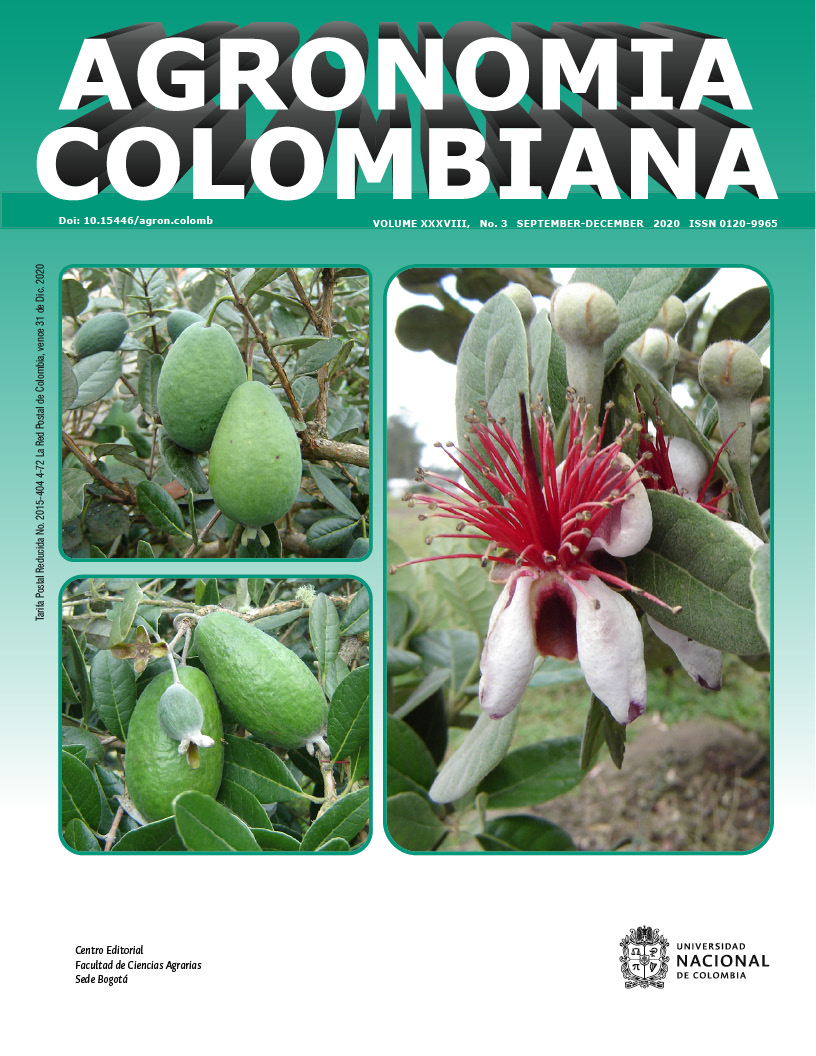Narrow and twin-row plantings do not increase maize yield
Siembras en hileras estrechas y mellizas no incrementan el rendimiento del maíz
DOI:
https://doi.org/10.15446/agron.colomb.v38n3.86117Keywords:
grain yield, plant arrangement, plant density (en)rendimiento de granos, distribuci´ón de plantas, densidad de plantas (es)
Downloads
Reducing row space and sowing in twin rows of maize (Zea mays L.) allow more equidistant plant distribution at the same density. The objective of this research was to evaluate the effect of these two management practices on the nitrogen content of the index leaf, the leaf area index at silking, and the grain yield of maize at different plant densities. The experiment was carried out in Lages, Santa Catarina State University, in southern Brazil during the growing seasons 2016-2017 and 2017-2018. A split-plot arrangement of a randomized complete block design was used. Two plant densities (7 and 9 plants m-2) were distributed in the main plot, and five row spaces (0.4, 0.6, 0.8, 1.0 m and twin rows 0.6 m apart with 0.18 m between rows) were evaluated in split-plots. Physiological traits and grain yield were determined on the maize hybrid P30R50YH. The experiments were sown on 10/20/2016 and 10/21/2017. Kernel yields were higher at the plant density of 9 plants m-2 than at 7 plants m-2. The row space did not affect the nitrogen content of the index leaf, the crop leaf area index at silking, and the maize grain yield. The increment of plant density was more effective than the use of narrow and twin rows to enhance P30R50YH hybrid grain yield.
La reducción del espacio entre líneas y la siembra en líneas dobles en maíz (Zea mays L.) permite una distribución más equidistante de las plantas con una misma densidad. El objetivo de este trabajo fue evaluar los efectos de dos prácticas de manejo sobre el contenido de nitrógeno en la hoja índice, el índice de área foliar del cultivo y el rendimiento de granos de maíz a diferentes densidades de plantas. El experimento fue realizado en Lages, en la universidad del estado de Santa Catarina, en el sur de Brasil, en los periodos de cosecha 2016/2017 y 2017/2018. Se utilizó un arreglo de parcelas divididas de un diseño experimental de bloques completos al azar. En la parcela principal se evaluaron dos densidades (7 y 9 plantas m-2) y en las subparcelas se evaluaron cinco espacios entre líneas (0.4 m, 0.6 m, 0.8 m, 1.0 m y líneas dobles de 0.6 m entre cada una y 0.18 m entre líneas del par). Se evaluaron las características fisiológicas y el rendimiento de granos del maíz hibrido P30R50YH, sembrado en 20/10/2016 y 21/10/2017. Los rendimientos de grano fueron
mayores en la densidad de 9 plantas m-2 que a 7 plantas m-2. El espacio entre filas no afectó el índice de contenido de nitrógeno en la hoja, el índice de área foliar del cultivo en el espigamiento, y el rendimiento de granos. El incremento en la densidad de plantas fue más eficiente que la reducción del espacio entre líneas y la siembra en líneas dobles para incrementar el rendimiento del hibrido P30R50YH.
References
Andrade, F. H., Calviño, P., Cirilo, A., & Barbieri, P. (2002). Yield responses to narrow rows depend on increased radiation interception. Agronomy Journal, 94(5), 975–980. https://doi.org/10.2134/agronj2002.9750
Argenta, G., Silva, P. R. F., & Sangoi, L. (2001). Arranjo de plantas em milho: análise do estado-da-arte. Ciência Rural, 31(6), 1075–1084. https://doi.org/10.1590/S0103-84782001000600027
Balbinot Jr., A. A., Trezzi, M. M., & Vogt, G. A. (2011). Integration of practice for the weed management in corn. Scientia Agraria, 12(2), 81–87. https://doi.org/10.5380/rsa.v12i2.33724
Balem, Z. (2013). Avaliação de espaçamento convencional e linhas gêmeas sob densidade populacional para cultura do milho. [Master’s thesis, Universidade Tecnológica Federal do Paraná]. UTFPR Repository. https://repositorio.utfpr.edu.br/jspui/bitstream/1/52/1/PB_PPGAG_M_Balem%2c%20Zenilson_2013.pdf
Barbieri, P. A., Saizs Rozas, H. R., Andrade, F. H., & Echeverría, H. E. (2000). Row spacing effects at different levels of nitrogen availability in maize. Agronomy Journal, 92, 283–288.
Barbieri, P. A., Echeverría, H., Saizs Rozas, H., & Andrade, F. H. (2008). Nitrogen use efficiency in maize as affected by nitrogen availability and row spacing. Agronomy Journal, 100(4), 1094–1100. https://doi.org/10.2134/agronj2006.0057
Boiago, R. G. F. S., Mateus, R. P. G., Schuelter, A. R., Barreto, R. R., Silva, G. J., & Schuster, I. (2017). Combinação de espaçamento entrelinhas e densidade populacional no aumento da produtividade em milho. Revista Brasileira de Milho e Sorgo, 16(3), 440–448. https://doi.org/10.18512/1980-6477/rbms.v16n3p440-448
Cantarella, H., & Marcelino, R. (2008). Fontes alternativas de nitrogênio para a cultura do milho. Informações Agronômicas, (122), 12–14.
CONAB. (n.d.). Serie Histórica das safras: Milho total (1a, 2a e 3a safra). Retrieved September 18, 2020, from https://www.conab.gov.br/info-agro/safras/serie-historica-das-safras?start=20
Fontoura, S. M. V., & Bayer, C. (2009). Adubação nitrogenada para alto rendimento de milho em plantio direto na região Centro-Sul do Paraná. Revista Brasileira de Ciência do Solo, 33, 1721–1732. https://doi.org/10.1590/S0100-06832009000600021
Hammer, G. L., Dong, Z., McLean, G., Doherty, A., Messina, C., Schussler, J., Zinselmeier, C., Paszkiewicz, S., & Cooper, M. (2009). Can changes in canopy and/or root system architecture explain historical maize yield trends in the U.S. Corn belt? Crop Science, 49(1), 299–312. https://doi.org/10.2135/cropsci2008.03.0152
Jeschke, M. R. (2014). Is the future of corn production in narrow rows? Pioneer. https://www.pioneer.com/us/agronomy/corn_production_narrow_rows.html
Kottek, M., Grieser, J., Beck, C., Rudolf, B., & Rubel, F.(2006) World map of the Köppen-Geiger climate classification updated. Meteorologische Zeitschrif, 15(3), 259-263. https://doi.org/10.1127/0941-2948/2006/0130
Lauer, S., Hall, B. D., Mulaosmanovic, E., Anderson, S. R., Nelson, B., & Smith, S. (2012). Morphological changes in parental lines of Pioneer Brand maize hybrids in the U.S. Central Corn Belt. Crop Science, 52(3), 1033–1043.
Lee, E. A., & Tollenaar, M. (2007). Physiological basis of successful breeding strategies for maize grain yield. Crop Science, 47(S3), 202–215. https://doi.org/10.2135/cropsci2007.04.0010IPBS
Leolato, L. S., Sangoi, L., Durli, M. M., Panison, F., & Voss, R. (2017). Growth regulator and maize response to the increase in plant density. Pesquisa Agropecuária Brasileira, 52(11), 997–1015. https://doi.org/10.1590/s0100-204x2017001100005
Novacek, M. J., Mason, S. C., Galuscha, T. D., & Yaseen, M. (2013). Twin rows minimally impact irrigated maize yield, morphology and lodging. Agronomy Journal, 105(1), 268–276. https://doi.org/10.2134/agronj2012.0301
Penariol, F. G., Filho, D. F., Coicev, L., Bordin, L., & Farinelli, R. (2003). Comportamento de cultivares de milho semeadas em diferentes espaçamentos entre linhas e densidades populacionais, na safrinha. Revista Brasileira de Milho e Sorgo, 2(2), 52–60.
Ritchie, S. W., Hanway, J. J., & Benson, G. O. (1993). How a corn plant develops. Iowa State University of Science and Technology.
Robles, M., Ciampiatti, I. A., & Vyn, T. J. (2012). Response of maize hybrids to twin-row spatial arrangement at multiple plant densities. Agronomy Journal, 104(6), 1747–1756. https://doi.org/10.2134/agronj2012.0231
Sangoi, L., Silva, P. R. F., & Argenta, G. (2010). Estratégias de manejo do arranjo de plantas para aumentar o rendimento de grãos de milho. Udesc.
Sangoi, L., Zanin, C. G., Schmitt, A., & Vieira, J. (2013).Leaf senescence and response of maize hybrids commercially released in different times to crowding. Revista Brasileira de Milho e Sorgo, 12(1), 21–32.
Sangoi, L., & Silva, P. R. F. (2016). Estratégias de manipulação do arranjo de plantas e desempenho agronômico do milho. In J. A. Wordell Filho, & L. A. Chiaradia. (Eds.), A cultura do milho em Santa Catarina (pp. 85–121). Epagri.
Sangoi, L., Schmitt, A., Durli, M. M., Leolato, L. S., Coelho, A. E., Kuneski, H. F., & Oliveira, V. L. (2019). Management of plant arrangement to optimize grain productivty in maize. Revista Brasileira de Milho e Sorgo, 18(1), 14–29. https://doi.org/10.18512/1980-6477/rbms.v18n1p47-60
SAS. (2016). Statistical Analysis System. SAS/INSIGHT User’s guide. SAS Institute Inc.
Schmitt, A. (2014). Arranjo de plantas para maximizar o desempenho agronômico do milho em ambientes de alto manejo. [Doctoral dissertation, Universidade do Estado de Santa Catarina]. UDESC Repository. https://www.udesc.br/arquivos/cav/id_cpmenu/1370/tese_amauri_15706374988225_1370.pdf
Serpa, M. S., Jandrey, D., & Silva, P. R. F. (2008, July 15–17). Redução do espaçamento entre-linhas no milho na época de semeadura do cedo da Depressão Central do Rio Grande do Sul, Brazil. [Conference presentation abstract]. 53ª Reunião Técnica Anual de Milho. Pelotas, Brazil. CD-ROM.
Sociedade Brasileira de Ciência do Solo - Comissão de Química e Fertilidade do Solo (2004). Milho. In: Manual de adubação e de calagem para os estados do Rio Grande do Sul e de Santa Catarina, (10), 140-143.
Strieder, M. L., Silva, P. R. F., Rambo, L., Sangoi, L., Silva, A. A., Endrigo, P. C., & Jandrey, D. B. (2008). Crop management systems and maize grain yield under narrow row spacing. Scientia Agricola, 65(4), 346-353.
United States Department of Agriculture (2010). Keys to soil taxonomy (11th ed). United States Department of Agriculture, Natural Resources Conservation Service.
Vargas, V. P., Sangoi, L., Ernani, P. R., Siega, E., Carniel, G., & Ferreira, M. A. (2012). Leaf attributes are more efficient than soil mineral N to evaluate the availability of this nutrient to maize. Bragantia, 71(2), 245–255. https://doi.org/10.1590/S0006-87052012000200014
How to Cite
APA
ACM
ACS
ABNT
Chicago
Harvard
IEEE
MLA
Turabian
Vancouver
Download Citation
CrossRef Cited-by
1. Dina Otto, Sebastian Munz, Waqas Ahmed Malik, Simone Graeff-Hönninger. (2024). Effect of row distance on plant architecture, weed suppression and yield of silage maize (Zea mays L.) and soybean (Glycine max (L.) Merr.) in a pesticide-free cultivation system in Southern Germany. Crop Protection, 185, p.106866. https://doi.org/10.1016/j.cropro.2024.106866.
2. Saseendran S. Anapalli, Srinivasa R. Pinnamaneni, Daryl R. Chastain, Krishna N. Reddy, Clyde Douglas Simmons. (2023). Eddy covariance quantification of carbon and water dynamics in twin-row vs. single-row planted corn. Agricultural Water Management, 281, p.108235. https://doi.org/10.1016/j.agwat.2023.108235.
Dimensions
PlumX
Article abstract page views
Downloads
License
Copyright (c) 2021 Agronomía Colombiana

This work is licensed under a Creative Commons Attribution-NonCommercial-ShareAlike 4.0 International License.
© Centro Editorial de la Facultad de Ciencias Agrarias, Universidad Nacional de Colombia
Reproduction and quotation of material appearing in the journal is authorized provided the following are explicitly indicated: journal name, author(s) name, year, volume, issue and pages of the source. The ideas and observations recorded by the authors are their own and do not necessarily represent the views and policies of the Universidad Nacional de Colombia. Mention of products or commercial firms in the journal does not constitute a recommendation or endorsement on the part of the Universidad Nacional de Colombia; furthermore, the use of such products should comply with the product label recommendations.
The Creative Commons license used by Agronomia Colombiana journal is: Attribution - NonCommercial - ShareAlike (by-nc-sa)

Agronomia Colombiana by Centro Editorial of Facultad de Ciencias Agrarias, Universidad Nacional de Colombia is licensed under a Creative Commons Reconocimiento-NoComercial-CompartirIgual 4.0 Internacional License.
Creado a partir de la obra en http://revistas.unal.edu.co/index.php/agrocol/.




















